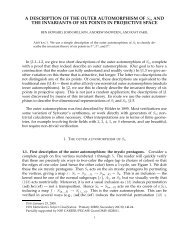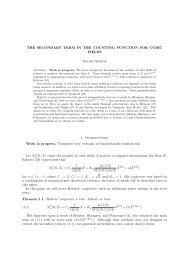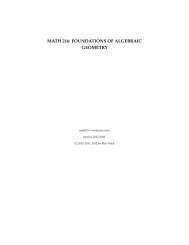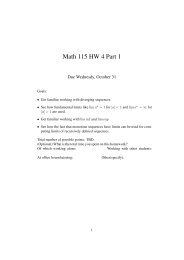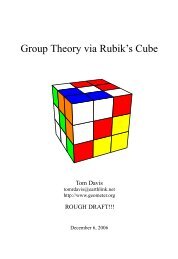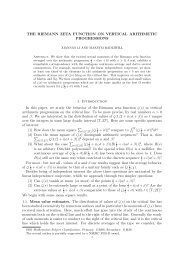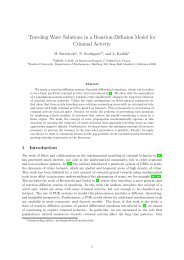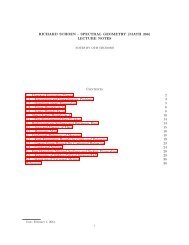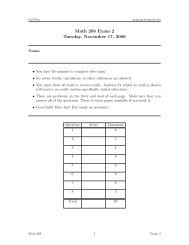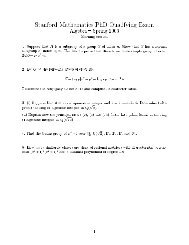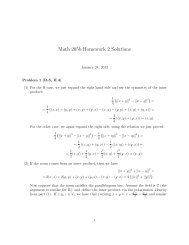Ph.D. Qualifying Exam, Real Analysis September 2006, part I Do all ...
Ph.D. Qualifying Exam, Real Analysis September 2006, part I Do all ...
Ph.D. Qualifying Exam, Real Analysis September 2006, part I Do all ...
Create successful ePaper yourself
Turn your PDF publications into a flip-book with our unique Google optimized e-Paper software.
<strong>Do</strong> <strong>all</strong> the problems.<br />
<strong>Ph</strong>.D. <strong>Qualifying</strong> <strong>Exam</strong>, <strong>Real</strong> <strong>Analysis</strong><br />
<strong>September</strong> <strong>2006</strong>, <strong>part</strong> I<br />
1 Let G be an unbounded open set in (0, ∞). Define<br />
Prove that D is dense in (0, ∞).<br />
D = {x ∈ (0, ∞) : nx ∈ G for infinitely many n}.<br />
2 Suppose that f ∈ L 1 ([0, 1]) but f /∈ L 2 ([0, 1]). Find a complete orthonormal basis {φn} for<br />
L 2 ([0, 1]) such that each φn ∈ C 0 ([0, 1]) and such that<br />
1<br />
0<br />
f(x)φn(x) dx = 0 ∀ n.<br />
3 Let H1 and H2 be two separable Hilbert spaces. Suppose that A : H1 → H2 is a continuous<br />
injective linear map. Suppose that {vj} is a bounded sequence in H1 such that Avj converges<br />
strongly in H2 to some element w. Prove that there exists an element v ∈ H1 such that vj<br />
converges weakly to v and Av = w.<br />
4 Some problems about linear functionals:<br />
a. Let T : C 0 ([0, 1]) −→ C be defined by T (f) = f(1/2). Is T continuous with respect to<br />
the L 2 norm? Explain why or why not.<br />
b. Let P denote the set of polynomials of arbitrary degree, and consider their restrictions to<br />
[0, 1] so as to consider P ⊂ C 0 ([0, 1]). Define the linear functional on P , Tk(f) = ak where<br />
ak is the coefficient of x k . <strong>Do</strong>es Tk extend as a continuous linear functional to <strong>all</strong> of C 0 ([0, 1])?<br />
Hint: Consider fn(x) = (1 − x) n , n ≥ k.<br />
5 Let Q = [0, 1] × [0, 1] and denote by X be the set of <strong>all</strong> closed nonempty subsets of Q. Define<br />
d(A, B) = inf{δ > 0 : A ⊂ Bδ and B ⊂ Aδ},<br />
where for any C ∈ X, Cδ = {x ∈ Q : dist (x, C) < δ}. Prove that (X, d) is a compact metric<br />
space.<br />
Hints: First prove that the subset of elements A ∈ X where A is finite is dense in X. Next,<br />
if {An} is a decreasing nested sequence of closed subsets of Q, ∩An = A, prove that An → A.<br />
Fin<strong>all</strong>y, if {Bn} is an arbitrary Cauchy sequence in (X, d), consider An = ∪k≥nAk.
<strong>Do</strong> <strong>all</strong> the problems.<br />
<strong>Ph</strong>.D. <strong>Qualifying</strong> <strong>Exam</strong>, <strong>Real</strong> <strong>Analysis</strong><br />
<strong>September</strong> <strong>2006</strong>, <strong>part</strong> II<br />
1 Let H be a Hilbert space with an orthogonal decomposition into finite dimensional subspaces,<br />
H = ∞ j=1 Hj. Thus each v ∈ H can be written uniquely as v = ∞ j=1 vj with vj ∈ Hj. Let<br />
c = (c1, c2, . . .) where each cj > 0, and define the subset<br />
Ac = {v : ||vj|| ≤ cj} ⊂ H.<br />
a. Prove that c ∈ ℓ 2 if and only if Ac is compact in H.<br />
b. Prove that every compact subset K ⊂ H is contained in some Ac for some c ∈ ℓ 2 .<br />
2 Let µ be a finite measure on R. Define its Fourier transform µ(ξ) = ∞<br />
−∞ e−ixξ dµ(x). Prove<br />
that<br />
3 Suppose that p, q, r ∈ [1, ∞) satisfy 1 1<br />
p + q<br />
|µ({x})| ≤ lim sup |µ(ξ)|.<br />
|ξ|→∞<br />
g ∈ L 1 (R), their convolution is an element of L r (R), and that<br />
∞<br />
|f ⋆ g| r ∞<br />
dx ≤<br />
−∞<br />
Hint: Use interpolation.<br />
= 1 + 1<br />
r . Prove that for every f ∈ Lp (R) and<br />
|f|<br />
−∞<br />
p dx<br />
r<br />
p ∞<br />
−∞<br />
|g| q r<br />
q<br />
dx .<br />
4 Let g : R → R be a C1 function such that g(x + 1) = g(x) for every x. Define<br />
∞<br />
f(x) = 2 −k g(2 k x).<br />
k=1<br />
Show that there exists A > 0 such that for <strong>all</strong> x, y ∈ R,<br />
|f(x) − f(y)| ≤ A |x − y| log |x − y| .<br />
Hint: If 2 −n−1 ≤ |x − y| ≤ 2 −n , divide the series for f into two <strong>part</strong>s.<br />
5 Suppose that f is a function from the natural numbers N to R + such that for every value of<br />
n, m ∈ N, f(n + m) ≤ f(n) + f(m). Prove that<br />
exists and equals<br />
f(n)<br />
lim<br />
n→∞ n<br />
f(n)<br />
inf<br />
n>0 n .



